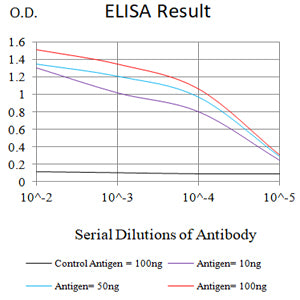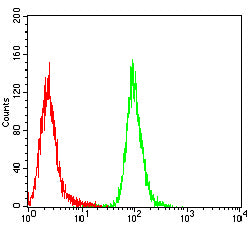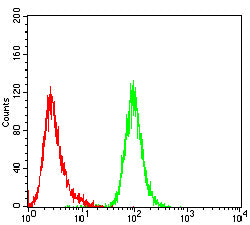


| WB | 咨询技术 | Human,Mouse,Rat |
| IF | 咨询技术 | Human,Mouse,Rat |
| IHC | 咨询技术 | Human,Mouse,Rat |
| ICC | 技术咨询 | Human,Mouse,Rat |
| FCM | 1/200 - 1/400 | Human,Mouse,Rat |
| Elisa | 1/10000 | Human,Mouse,Rat |
| Aliases | CMK; MIG; Humig; SCYB9; crg-10 |
| Entrez GeneID | 4283 |
| clone | 7E4A10 |
| WB Predicted band size | 14kd |
| Host/Isotype | Mouse IgG2a |
| Antibody Type | Primary antibody |
| Storage | Store at 4°C short term. Aliquot and store at -20°C long term. Avoid freeze/thaw cycles. |
| Species Reactivity | Human |
| Immunogen | Purified recombinant fragment of human CXCL9 (AA: 23-125) expressed in E. Coli. |
| Formulation | Purified antibody in PBS with 0.05% sodium azide |
+ +
以下是3篇关于CXCL9抗体的代表性文献摘要(基于公开信息整理,部分内容可能需核实原文):
---
1. **文献名称**: *CXCL9 as a Biomarker in Anti-PD-1 Therapy for Melanoma*
**作者**: Gajewski TF, et al.
**摘要**: 研究通过免疫组化(使用CXCL9抗体)发现,肿瘤微环境中CXCL9高表达的黑色素瘤患者对PD-1抑制剂治疗反应更佳,提示CXCL9可作为预测免疫治疗疗效的生物标志物。
---
2. **文献名称**: *CXCL9 Neutralization Attenuates Autoimmune Inflammation in Lupus Models*
**作者**: Antonelli A, et al.
**摘要**: 在小鼠狼疮模型中,使用抗CXCL9抗体阻断趋化因子信号后,Th1细胞向靶器官的浸润减少,显著缓解肾脏炎症和疾病进展,表明CXCL9是自身免疫病潜在治疗靶点。
---
3. **文献名称**: *CXCL9 Detection in Viral Infections Using Monoclonal Antibodies*
**作者**: Lane BR, et al.
**摘要**: 开发了一种特异性识别CXCL9的单克隆抗体,用于ELISA和流式检测HIV感染患者外周血中CXCL9水平升高,证实其与病毒载量及免疫激活正相关。
---
4. **文献名称**: *CXCL9 Guides T Cell Migration in Inflammatory Diseases*
**作者**: Chtanova T, et al.
**摘要**: 通过体内成像结合抗CXCL9抗体阻断实验,证明CXCL9通过结合CXCR3受体介导效应T细胞向炎症部位的定向迁移,为调控免疫细胞迁移提供机制依据。
---
如需具体文献来源,建议通过PubMed或Web of Science以“CXCL9 antibody”为关键词检索最新论文。
CXCL9. also known as monokine induced by gamma interferon (MIG), is a small chemokine belonging to the CXC subfamily. It is primarily produced by immune cells, including macrophages, dendritic cells, and endothelial cells, in response to pro-inflammatory cytokines such as IFN-γ. CXCL9 plays a critical role in recruiting activated T cells and natural killer (NK) cells to sites of inflammation or infection by binding to its receptor CXCR3. This chemokine is closely associated with Th1-mediated immune responses and has been implicated in various pathological conditions, including autoimmune diseases (e.g., rheumatoid arthritis, multiple sclerosis), chronic inflammatory disorders, and cancer. In tumor microenvironments, CXCL9 expression often correlates with enhanced anti-tumor immunity and improved responses to immunotherapies.
CXCL9 antibodies are essential tools for detecting and quantifying CXCL9 protein levels in research and diagnostic applications. They enable the study of CXCL9's spatial and temporal expression patterns in tissues or biofluids using techniques like ELISA, Western blotting, and immunohistochemistry. Additionally, neutralizing anti-CXCL9 antibodies are employed in preclinical studies to investigate the chemokine's functional roles by blocking its interaction with CXCR3. Recent studies explore therapeutic potential, such as modulating CXCL9 signaling to suppress excessive inflammation in autoimmune conditions or enhance T-cell infiltration in "cold" tumors. However, clinical applications remain experimental, requiring further validation of antibody specificity and safety. Research on CXCL9 antibodies continues to advance understanding of immune regulation and therapeutic targeting in inflammatory and neoplastic diseases.
×